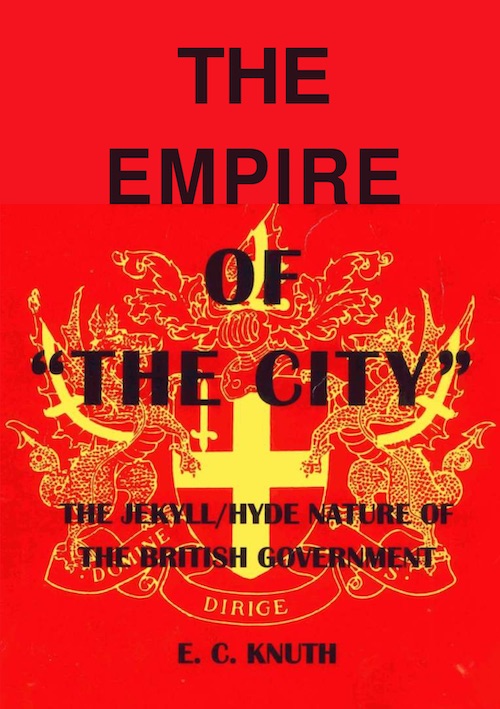E C Knuth
The Empire of the City (1946)

A highly-important and well-referenced look at the operation at The City of London, at the heart of The British Empire and its global role throughout the previous century of history.
The Empire of the City (1946) by E. C. Knuth
Introduction
At the end of World War I, the writer, then 27 years old, was released from the U. S. Army aa a second lieutenant of the Coast Artillery Corps. Like many more servicemen, he was filled with resentment as the deluge of utterly obvious and brazen falsehood, by which participation in that war had been forced upon the American people, was exposed, and became more evident day by day after the war waa won.
That the reasons advanced to the American people for their entry into World WarI werelargelyfraudulent becamecommonandacceptedknowledge, axid over 25 years after the end of that war the eminent American historians, Charles A. and Mary R. Beard, stated in their "Basic History" (page 442) that "the gleaming mirage that pictured the World War as purely or even mainly a war for democracy and civilization dissolved beyond recognition...' and the well-known Internationalist publicist, Walter Lippmann, stated in his "U. S. Foreign Policy" (page 24) in effect that the real reasons for going to war in 1917 have never been admitted.
Many people realize that this mystifying situation, in which an alleged democratic and self-governing nation is actually controlled against the will of the people in its foreign affairs, is a clear indication that there must be a very powerful and well-financed secret organization which plans and directs American foreign affairs and for lack of a more specific identification this suspected secret organization is popularly referred to as the International Financiers.
When the propaganda mills began their characteristic grind towards war in the early 1930's, the writer began a more definite study of international power politics, and soon found it an entrancing and revealing subject. There was, however, no more free speech; and the most amazing documented aspects of a vast secret world order of International Finance could find no hearing in a situation where some Congressmen denounced overwhelming Nationalist expression of views in their mail as mere organized subversion.
The shelves of our public libraries hold thousands of books pertaining to some aspect of this vast subject; most of them dry as dust to the average reader and remaining unread by the public through the years. Most of these scholarly works are devoted to some passing phase of power politics in some part of the world, of which their author has made a specialized study, and have invariably been forgotten as the public has lost interest in that particular incident.
In running through these works some amazing nuggets of information come to light here and there, which fitted together gradually unfold the stunning history and the legal structure of a sovereign world state located in the financial district of the loosely knit aggregation of boroughs and cities popularly known as the city of London. The colossal political and financial organization centered in this area, known aa "The City," operates aa a super-government of the world; and no incident occurs in any part of the world without its participation in some form.
Its pretensions are supported in the United States by the secret International Pilgrim Society, sponsor of the Cecil Rhodea "One World" ideology which was launched about 1897. The president of its American branch is Dr. Nicholas Murray Butler, who is also president of the allied Carnegie Endowment for International Peace. The ultimate objective of this camarilla was defined by one of its noted propagandists, the late William Allen White, aa: "It is the destiny of the pure Aryan Anglo-Saxon race to dominate the world and kill off or else reduce to a servile status all other inferior ram."
After reducing the vast mess of data forming the basis of this work into a logical and readable sequence, it was finally put into print and privately published after long delay, and copyright was granted May 22, 1944. About 200 copies were sent to various members of Congress, thus largely performing the purpose of the first edition. Several members of the Senate Foreign Relations Committee accorded some attention to this.
Senator Henrik Shipstead of Minnesota wrote August 12, 1944: "The document containing the result of your research was so interesting that it spoiled most of my sleep that night . . . I have been doing some research along the same lines and i find my time in that respect is limited. You have done a great deal of work that will save me a great deal of time." On August 21,1944, he wrote: "People ought to be induced to read it. It is a documented piece of work and therefore should command respect and arouse interest."
This work apparently appeals moat strongly to men of professional standing, and to people of the elder generations, and a number of lawyers, doctors, clergymen, architects and engineers of the writer's acquaintance have expressed their great interest and apparently general commendation. Publishers approached have been reluctant to undertake it, and several stated that there would be little demand for a serious work of this kind, as the American public is not interested in that kind of reading matter. One large Eastern publisher frankly wrote he was obliged to disregard the recommendations of his readers on advice of counsel.
Chapters I and XI, and the Conclusion, are new additions to the second edition of "The Empire of 'The City'." Chapter XI, "A Study in Power," was published separately and copyrighted February 22, 1945.
Downloads and Links
- We have written a blog with some highlights from the book Empire of the City
- Download The Empire of the City (1946) by E. C. Knuth - PDF (1.8 MB) - 113 pages.
- Download The Empire of the City (1983 Reprint) by E. C. Knuth - PDF (2 MB) - 111 pages.
- Read The Empire of the City on The Internet Archive and download in different formats
- Web search for the book by ISBN:9781585092628
- Web search for the book by author and title
